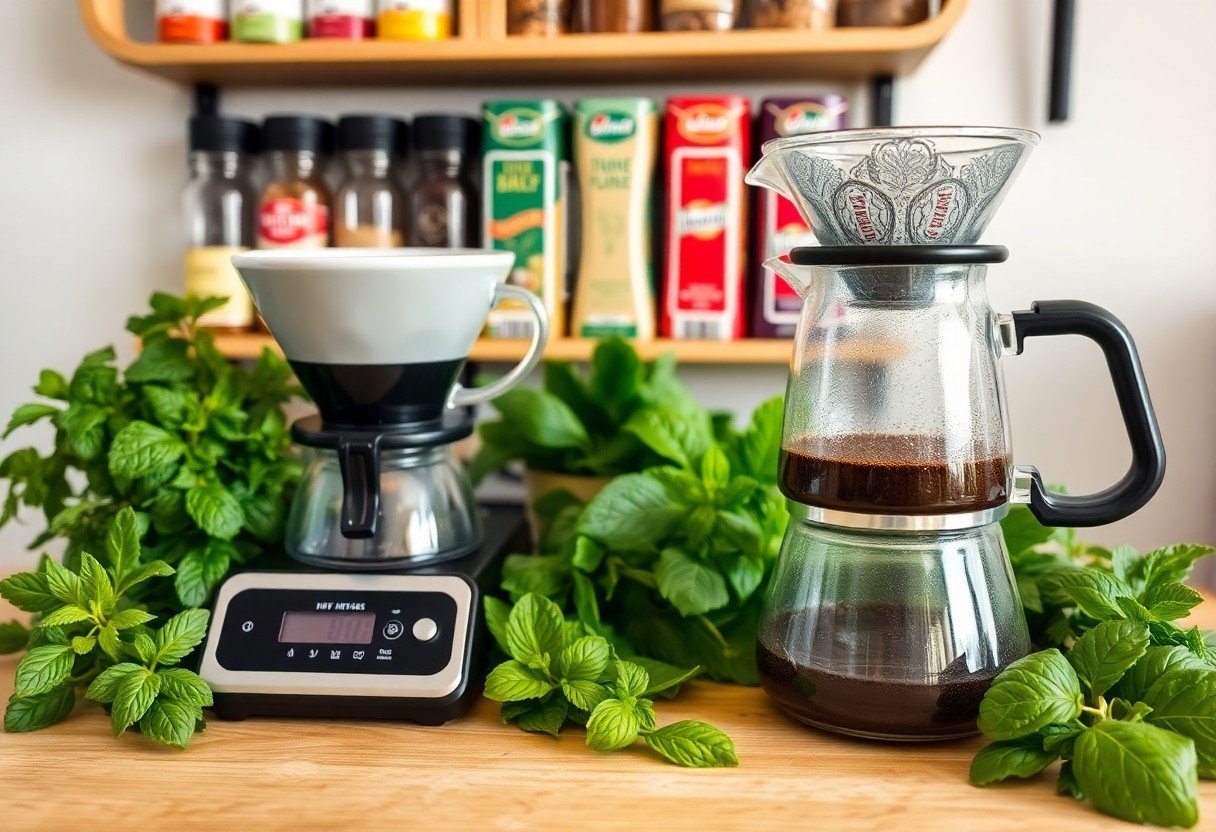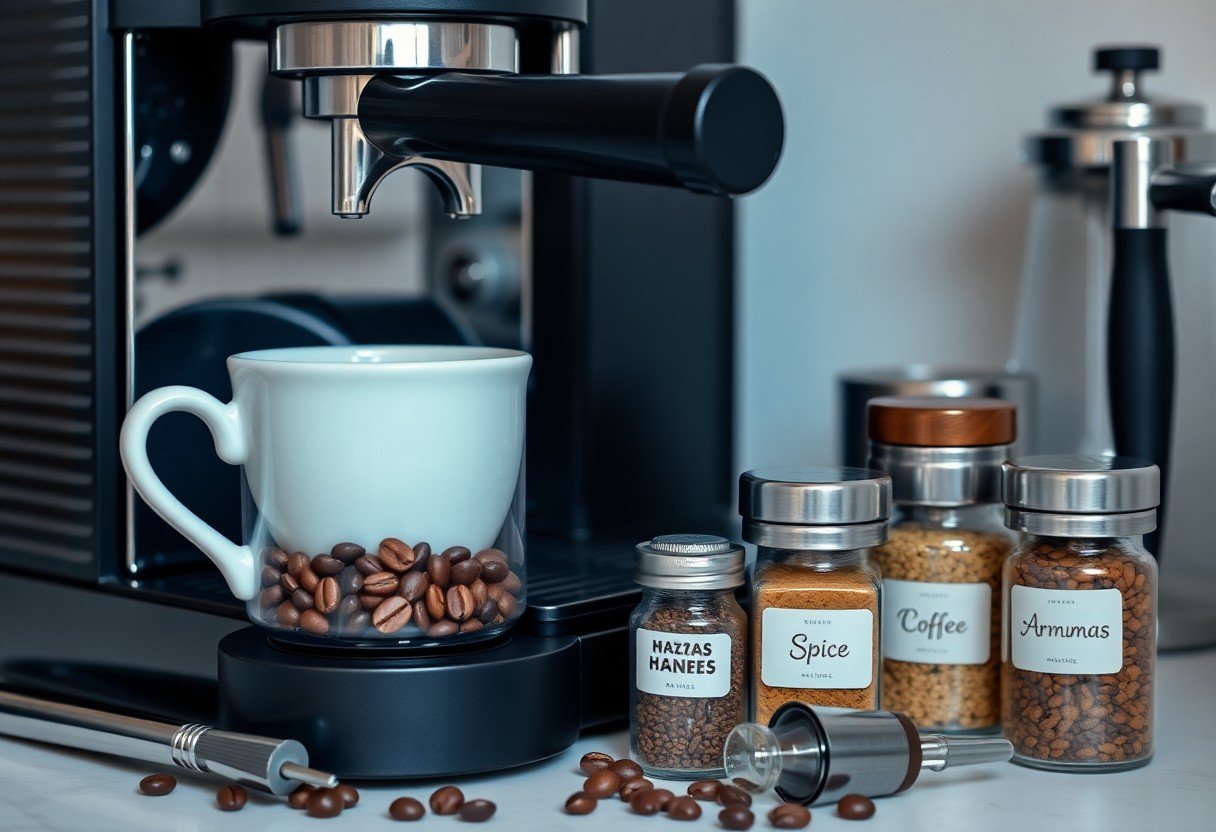Brewing an exceptional cup of coffee at home involves understanding how aroma synergy enhances your overall experience. By exploring the interplay of various aromatic compounds, you can elevate your brewing technique and fully appreciate the flavors in your cup. This guide will explore into the science behind aroma synergy, offering practical tips on how to optimize your brewing process for a distinguished taste that delights your senses.

The Science of Aroma in Brewing
Aroma plays a pivotal role in brewing coffee, significantly influencing your sensory experience. As coffee beans roast, complex chemical reactions evoke a plethora of aromatic compounds. Each variety releases unique scents that can feel both familiar and exotic, guiding your palate towards distinct flavor notes. Mastering the aroma can elevate your home brewing, transforming a simple cup into an unforgettable experience.
Molecular Composition of Coffee Aromas
The molecular composition of coffee aromas is a fascinating blend of various organic compounds. Over 800 volatile substances contribute to the fragrant bouquet, including esters, aldehydes, and phenols. These molecules interact with one another, forming intricate aromatic profiles that trigger your olfactory senses. Notably, certain compounds, like 2-furfurylthiol, are responsible for the enticing smell of freshly brewed coffee, evoking warmth and comfort.
The Role of Volatile Compounds in Flavor Profile
Volatile compounds significantly enhance your coffee’s flavor profile by providing depth and complexity. They are responsible for the enticing aromas that bloom as soon as the brewed coffee hits the cup. High-quality beans often contain a higher concentration of these compounds, enriching the overall tasting experience. For instance, the presence of specific terpenes contributes floral notes, while furans can impart sweetness and toasty undertones. Understanding the balance of these compounds helps you appreciate the nuances in each brew.
Digging deeper into volatile compounds reveals their intricate role in your coffee’s tasting notes. For example, compounds like 3-methyl-2-butenal create a sweet, caramel-like aroma, while certain aldehydes introduce fruity or nutty characteristics. Not only do these aromas set the stage for flavor, but they also dictate how you perceive acidity and body in your cup. You can experiment with different brewing methods and bean types to discover which aromas resonate best with your preferences, enhancing your coffee experience. By focusing on the interplay of volatile compounds, you gain insight into the craftsmanship behind your morning brew.
Aroma Synergy: Crafting a Flavorful Experience
Aroma synergy plays a pivotal role in elevating your brewing experience, enhancing the intricate tapestry of flavors in your cup. By carefully selecting and combining aromatic profiles, you create a multi-dimensional sensory journey that captivates the palate. Utilizing complementary aromas, such as floral notes with rich chocolate undertones, can significantly enhance the overall tasting experience, leaving an indelible mark on your enjoyment of every sip.
How Different Aromas Complement Each Other
Different aromas can elevate your coffee, transforming a simple brew into a complex flavor experience. For instance, pairing bright citrus notes with earthy undertones creates a balance that enhances both profiles. You might find that a hint of spice complements sweet, fruity scents, leading to a fuller sensory experience that captivates your taste buds and keeps you engaged throughout your cup.
The Impact of Aroma on Flavor Perception
Aroma is fundamental to how you perceive flavor, with smell accounting for approximately 80% of what you taste. As you sip your brew, aromatic compounds activate olfactory receptors, influencing your overall flavor experience. This interaction can enhance or modify perceived sweetness, bitterness, or acidity in your coffee. Understanding this relationship allows you to craft brews that maximize their aromatic potential for a more enjoyable drinking experience.
When brewing, the interplay between aroma and flavor perception is remarkable. For example, a coffee with intense fruitiness may taste sweeter when complemented by underlying floral notes due to their olfactory association. The physiological response to aromas elevates flavors, making them brighter and more complex. Experimenting with various origins, roast levels, and brew methods allows you to discover unique combinations that enhance your coffee’s characteristics, ultimately enriching your home brewing journey.
Brewing Techniques to Enhance Aroma Synergy
Utilizing specific brewing techniques can significantly enhance the aroma synergy of your coffee, ensuring a distinguished cup at home. Methods such as precise grinding, optimal water temperature, and controlled brewing times work together to unlock the full aromatic potential of your beans, creating a harmonious flavor profile that resonates with your palate.
Optimal Grinding Methods for Aroma Release
The grind size directly affects aroma release during brewing. Finer grinds expose more surface area, leading to quicker extraction of aromatic compounds, while coarser grinds allow for slower extraction, ideal for methods like French press. Finding the right balance is vital to achieve the desired flavor notes without over-extraction that can lead to bitterness.
Water Temperature and Brewing Time Considerations
Water temperature and brewing time play a significant role in aroma extraction. Optimal brewing typically occurs between 195°F to 205°F (90°C to 96°C), with brewing times varying based on the method. For instance, espresso requires 25-30 seconds, while pour-over may take 3-4 minutes, creating distinct aromatic profiles that reflect the brew method.
Water Temperature and Brewing Time Considerations
| Temperature Range | 195°F – 205°F (90°C – 96°C) |
| Espresso Brewing Time | 25-30 seconds |
| Pour-Over Brewing Time | 3-4 minutes |
| French Press Brewing Time | 4 minutes |
Water temperature and brewing times are integral to highlighting the complexity of coffee aromas. Falling outside the optimal range can mute delicate flavors or amplify undesirable bitterness. Precision in both aspects helps you craft a coffee experience where each sip reveals a distinct layer of aroma, contributing to the overall sensory delight.
Sourcing Beans for Maximum Aroma Potential
To brew a distinguished cup at home, sourcing high-quality coffee beans is important for maximizing aroma potential. Look for single-origin varieties that highlight specific flavor profiles and characteristics. Consider freshness and choose roasters who prioritize direct trade practices, ensuring both quality and sustainability. Paying attention to these factors not only enhances aroma but also supports responsible sourcing practices within the coffee community.
The Importance of Origin and Processing Methods
The origin of your coffee beans significantly impacts aroma and flavor. Beans from regions like Ethiopia or Colombia often have unique profiles owing to their specific growing conditions. Additionally, processing methods—such as natural or washed—affect aroma compounds. Natural processing can enhance fruity notes, while washed methods often produce a cleaner cup, allowing you to explore a variety of aromatic experiences with each brew.
Evaluating Freshness: A Key to Aroma Integrity
Freshness directly influences aroma integrity, as coffee beans lose volatile compounds over time. Beans should ideally be consumed within two weeks of roasting to preserve their aromatic qualities. Look for purchase dates on packaging and choose smaller batches when possible to enjoy optimal freshness. Store your beans in a cool, dark place to prevent degradation.
Evaluating freshness involves more than just checking the roast date; the best way to ensure you’re brewing with vibrant aroma is through sensory assessment. A well-preserved bean should exhibit a strong, pleasing scent immediately upon opening the bag. Conduct a smell test before brewing; stale beans will lack the vivid aromatic compounds necessary for an exceptional cup. Consuming coffee within two weeks of roast ensures you’re capitalizing on its full flavor profile, as the aroma compounds begin to diminish significantly afterward. Prioritizing freshness not only elevates your brewing experience but also enhances the overall enjoyment of the coffee journey.

Elevating Your Brewing Ritual: Tips from the Experts
Enhancing your brewing ritual transforms an ordinary experience into a sophisticated affair. Experts suggest focusing on three key areas: the quality of your ingredients, the precision of your equipment, and the mindfulness of your process. Consider the following tips:
- Invest in a quality grinder for consistent particle size.
- Experiment with water temperature and brew time for optimal extraction.
- Engage your senses; smell the beans pre- and post-brew.
Thou shall create a ritual that captivates both the palate and the nose.
Tactical Equipment Choices for Aroma Enhancement
Your choice of equipment can significantly elevate the aroma of your coffee. Using a precise scale ensures accurate coffee-to-water ratios, while a high-quality burr grinder maintains consistent grind size, maximizing aroma extraction. An immersion brew method, like a French press, allows oils to escape and bloom effectively, enhancing the overall aroma profile of the brew.
Mindfulness in Brewing: Engaging the Senses
Engaging in mindfulness during the brewing process sharpens your senses, enhancing the overall coffee experience. Focusing on the aroma, texture, and flavor can transform the act of brewing into a sensory ritual. Noticing the intricate scents that arise while grinding or brewing allows you to better appreciate the complexity of your coffee.
Mindfulness in brewing opens a deeper connection to your coffee. As you focus on the aroma and flavors, allow yourself to be fully present in the moment, observing how each aspect of the coffee interacts. Engaging your senses elevates brewing from a routine activity to an art form, heightening your awareness of the nuances that differentiate an ordinary cup from a distinguished one. This immersive experience encourages a richer appreciation of the craft, making every sip even more rewarding.
Final Words
The aroma synergy plays a pivotal role in elevating your home brewing experience. By understanding how the various scents interact with the flavors of your coffee or tea, you can significantly enhance the overall taste and enjoyment. Experimenting with different ingredients and brewing techniques allows you to discover the unique aromatic profiles that resonate with your palate. This intentional focus on aroma transforms a simple brewing process into a refined art, ensuring that each cup you create is not only distinguished but also tailored to your personal preferences.
FAQ
Q: What is aroma synergy in brewing?
A: Aroma synergy refers to the combination of different aromas from coffee beans, additives, and brewing methods that work together to enhance the overall flavor experience of a cup of coffee.
Q: How can I identify the aromas in my coffee?
A: To identify aromas, inhale deeply from the brewed coffee after it has cooled slightly. Noting the scent before drinking can help distinguish various notes such as fruity, nutty, or floral aspects.
Q: Which brewing methods best highlight aroma synergy?
A: Brewing methods like pour-over, French press, or Aeropress typically emphasize aroma synergy, as they allow for better extraction of aromatic compounds compared to standard drip coffee makers.
Q: Can additives like spices or flavorings enhance aroma synergy?
A: Yes, adding ingredients such as cinnamon, vanilla, or flavored syrups can complement and elevate the existing aromas in coffee, creating a more complex and enjoyable taste experience.
Q: What role does grind size play in aroma synergy?
A: Grind size affects extraction and surface area; a consistent, appropriate grind enhances the release of aromatic oils, leading to a more balanced and fragrant cup of coffee.

